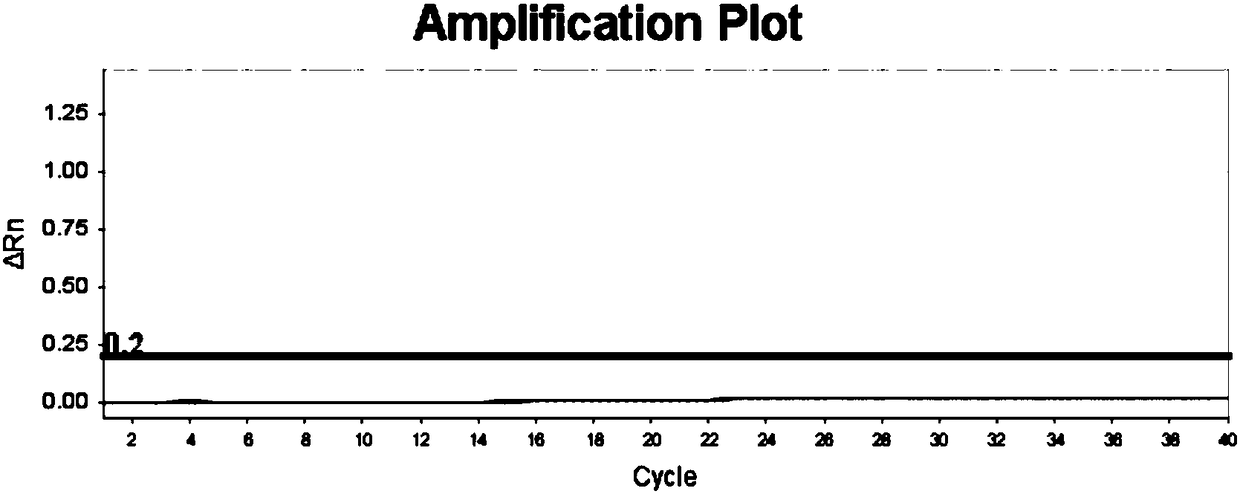SNP (single nucleotide polymorphism) molecular marker for identifying taxus cuspidata and application of SNP molecular marker
A molecular marker, yew technology, applied in the field of molecular biology, can solve the problems of subjective discrimination bias and morphological differences, and achieve simple operation, high specificity and high sensitivity, and objective results in the identification process
- Summary
- Abstract
- Description
- Claims
- Application Information
AI Technical Summary
Problems solved by technology
Method used
Image
Examples
Embodiment 1
[0062] Example 1 Obtaining of Taxus chinensis SNP molecular markers
[0063] 1. According to the t r n gene disclosed in the NCBI database, design corresponding primers for PCR amplification, using the upstream primer F1: 5'-GCAGAGACTCAACGGAAGAT-3' (SEQ ID NO.2), and the downstream primer R1: 5'-CCCTATTTATCATCCAAGCG-3' (SEQ ID NO.3), and the following PCR reaction system and PCR reaction program, with the identified southern yew (Taxus mairei SY Hu), Mandia yew (Taxus madia), European yew (Taxusbaccata), The genomic DNA of six taxus species from Tibet (Taxus wallichiana Zucc.), northeast yew (Taxus cuspidata S.etZ.) and Yunnan yew (Taxus yunnanensis Cheng et L.K.F) were used as templates for PCR amplification. The product was detected by 1.5% agarose gel electrophoresis and sequenced after being observed by the ultraviolet gel imaging system.
[0064]
[0065]
[0066] Among them, Vazyme AceTaq DNase (product number p401-d1 250U).
[0067] Extract plant genomic DNA acc...
Embodiment 2
[0071] Example 2 Application of Taxus chinensis SNP Molecular Marker in the Identification of Taxus chinensis by Fluorescent PCR Amplification
[0072] In this example, on the basis of obtaining the SNP site of Taxus chinensis, specific upstream primer F2, downstream primer R2 and probe P2 were designed for the gene sequence containing the SNP site using PrimerPremier5.0, and the primers and The probe was synthesized by Suzhou Jinweizhi Biotechnology Co., Ltd. The specific primers and probes are used to carry out fluorescent PCR amplification detection on Taxus chinensis, Taxus mandia, Taxus chinensis, Taxus tibetan, Taxus chinensis and Taxus yunnanensis. Specifically, the sequence of the upstream primer F2, the sequence of the downstream primer R2 and the sequence of the probe P2 are respectively:
[0073] Upstream primer F2: 5'-AGGTTGATCGTAAGATCAACTCATAT-3' (SEQ ID NO.4)
[0074] Downstream primer R2: 5'-AATTGTATGTATAATACAATTATAC-3' (SEQ ID NO.5)
[0075] Probe P2: 5'-TTA...
Embodiment 3
[0085] Example 3 Application of Northeast Taxus SNP Molecular Marker in Identification of Northeast Taxus by ARMS-PCR
[0086] In this example, on the basis of obtaining the SNP site of Taxus chinensis, specific upstream primer F3 and downstream primer R3 were respectively designed for the gene sequence containing the SNP site by using PrimerPremier5.0. Suzhou Jinweizhi Biotechnology Co., Ltd. Ltd Synthetics. The ARMS-PCR method is used to detect the samples of Taxus chinensis, Taxus Mandia, Taxus Europe, Taxus Tibet, Taxus Northeast China and Taxus Yunnan by using the specific primers. Specifically, the sequence of the upstream primer F3 and the sequence of the downstream primer R3 are respectively:
[0087] Upstream primer F3: 5'-AGGTTGATCGTAAGATCAACTCACAT-3' (SEQ ID NO.7)
[0088] Downstream primer R3: 5'-CAGAACCTGAGCTCAGGTCAACT-3' (SEQ ID NO.8)
[0089] Using the genomic DNA of 6 taxus species as templates, the 20 μL PCR reaction system includes:
[0090]
[0091] ...
PUM
 Login to View More
Login to View More Abstract
Description
Claims
Application Information
 Login to View More
Login to View More - R&D
- Intellectual Property
- Life Sciences
- Materials
- Tech Scout
- Unparalleled Data Quality
- Higher Quality Content
- 60% Fewer Hallucinations
Browse by: Latest US Patents, China's latest patents, Technical Efficacy Thesaurus, Application Domain, Technology Topic, Popular Technical Reports.
© 2025 PatSnap. All rights reserved.Legal|Privacy policy|Modern Slavery Act Transparency Statement|Sitemap|About US| Contact US: help@patsnap.com



